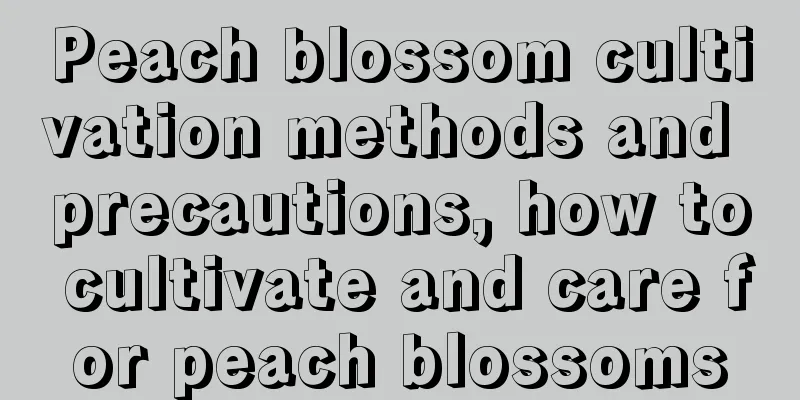Peach blossom cultivation methods and precautions, how to cultivate and care for peach blossoms

1. Breeding methods1. Soil: Peach blossoms grow well in soft and fertile soil. Good drainage can prevent the roots from being flooded and also helps their breathing. Generally, a mixture of leaf mold, river sand and garden soil is needed. Some broken tiles can also be placed at the bottom of the pot to allow moisture to drain as quickly as possible. 2. Light: Peach blossom is a light-loving plant, so it must be provided with sufficient light, with the light time reaching no less than 8 hours a day. If the environment is too dark, the plant will easily grow too tall, which will not only look unsightly but also affect its flowering. 3. Watering: Peach blossoms have a certain degree of drought resistance and do not require much water, so they do not need too much watering. Check the dryness of the soil in the pot regularly. If the topsoil is dry, it means you can water it. The soil should be kept slightly moist during the growing season and a little drier in winter. 4. Fertilization: When planting peach blossoms in pots, base fertilizer needs to be applied first. The base fertilizer is usually applied to the bottom of the pot, so that nutrients can be continuously provided. During its growing period, top dressing is generally done once every 20 days, with mostly dilute liquid fertilizers. Before flowering, phosphorus and potassium fertilizers should also be added to promote flowering of the plant. 2. PrecautionsWhen growing peach blossoms, you must pay attention to controlling the amount of watering and fertilization. Excessive water or fertilizer can easily cause the roots of the plants to rot. In this case, you need to remove the plants from the pots and prune them in time, and change the soil and replant them. In addition, you cannot use tap water directly for watering. You need to let it dry for a few days to allow the chlorine in the water to evaporate before using it. |
<<: High-yield cultivation technology of cucumber
>>: Cultivation and management of strawberries in solar greenhouse
Recommend
Does the tiger lily bloom?
1. Is it blooming? The leaf shape of Tiger Pira i...
Is Fragrant Wood Toxic?
1. Is it toxic? I just want to tell all my friend...
The use of foliar fertilizer for hydroponic flowers
1. Purchase Choose the right foliar fertilizer ac...
How to change the pot and soil of Clivia?
Clivia has become a popular ornamental potted pla...
How to grow gooseberries
1. Breeding methods 1. Temperature: It is mainly ...
How to grow goldfish spider plant
1. Potting soil When growing goldfish spider plan...
When and how to plant peppers
Chili pepper planting time The planting time of c...
Cherry blossoms' growing environment and local conditions
Cherry Blossom Growth Environment and Conditions ...
Smooth Sailing sowing steps, Smooth Sailing other propagation methods
1. Sowing steps 1. Obtain seeds: Before sowing an...
Cultivation methods and precautions of green bead grass
1. Maintenance methods 1. Light management: When ...
Cultivation and precautions of osmanthus trees
1. Breeding methods 1. Soil: Osmanthus trees grow...
Which month is the best time to plant corn?
In my country, corn is divided into spring-sown c...
He made the flowers bloom in just one month. How did he do it?
Kalanchoe Kalanchoe can be propagated by leaf cut...
Can lucky bamboo survive in the soil? How to grow lucky bamboo in soil?
1. Can it survive in the soil? Of course lucky ba...
The flowers my neighbor grows on his north balcony are more beautiful than those on my south balcony. How did he do that?
asparagus Almost all flower lovers know that aspa...









